Condition of tires and rims
Drive over sharp-edged obstacles at low speed and, if possible, move perpendicular to the obstacle. Hitting sharp objects can damage the tire and rim. When parking, do not lap the tires against the curb.
Check wheels regularly for damage. In case of damage or unusual wear, contact the service center.
Winter tires
Winter tires improve driving safety at temperatures below 7°C and must therefore be fitted to all wheels.
Tire designations
For example, 215/60 R 16 95 H
- 215: Tire width, mm
- 60: Cross section aspect ratio (tire height to tire width), %
- R: Cord type: radial
- RF: Type: RunFlat
- 16: Wheel diameter, inches
- 95: Tire load rating, e.g
- 95 is equivalent to 690 kg
- H: Speed code letter
Speed code letter:
- Q: up to 160 km/h
- S: up to 180 km/h
- T: up to 190 km/h
- H: up to 210 km/h
- V: up to 240 km/h
- W: up to 270 km/h
Tire pressure
Check cold tire pressure at least every 14 days and before every long trip. Be sure to check the spare tire pressure.
Unscrew the valve cap.
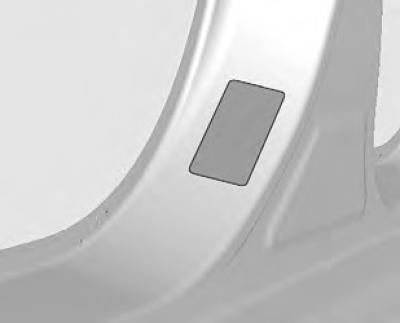
Tire pressure decal on driver's door frame.
Pressure data are given for cold tires. The data applies to both winter and summer tyres.
Always inflate the spare tire to the pressure for a fully loaded vehicle.
Incorrect tire pressure reduces driving safety, impairs handling, comfort, fuel efficiency and leads to accelerated tire wear.
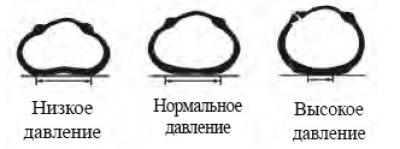
Note: Check air pressure with cold tires. As tires heat up, their pressure rises. Tires can get hot after 1.6 km, it takes three hours to cool down (after stopping the car).
Warning: Excessively low pressures can cause tires to heat up and cause internal tire damage that can cause tread separation and, at high speeds, even tire blowout.
Tire pressure monitoring system
The tire pressure monitoring system checks the pressure in all four tires every minute when the vehicle speed is above a certain limit.
All wheels must be equipped with pressure sensors, tire pressure must correspond to passport values. If the vehicle is fitted with wheels without sensors, the tire pressure monitoring system will not function. Install sensors if possible.
Tread depth
Check the tread depth regularly.
For safety reasons, it is necessary to change tires when the tread depth decreases to 2-3 mm (4 mm for winter tires).
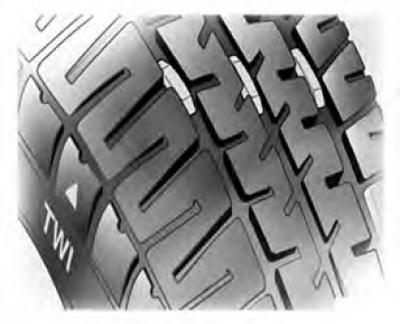
Regulated minimum tread depth (1.6mm) corresponds to the appearance of wear indicators (TWI). Indicator locations are marked on the sidewall of the tire.
If the front wear is higher than the rear, swap the front and rear wheels. Make sure that the direction of rotation of the wheels does not change.
Tires age even when not in use. It is recommended to change tires every 6 years.
Direction of tire rotation
Tires must be swapped to ensure that all tires wear more evenly. The first permutation is the most important.
If unusual wear is noticed, swap tires as soon as possible and check wheel alignment. Also make sure that the tires and wheels are not damaged.
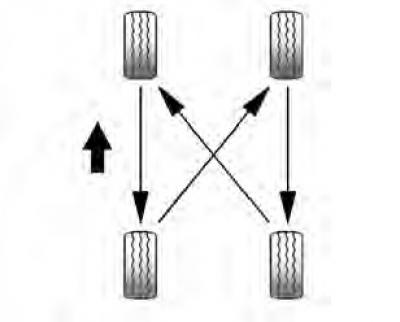
When swapping tires, be sure to follow the swapping order shown. Do not use the spare wheel when changing tires. Adjust the pressure in the front and rear tires according to the recommended values on the tire data plate and the maximum allowable load after changing the tires.
Reset the tire pressure monitoring system.
Make sure all wheel nuts are securely tightened.
Warning: Corrosion and dirt on the wheel or the parts it is attached to can cause the wheel nuts to loosen over time. The wheel may come off and cause an accident. When replacing a wheel, remove any corrosion and dirt from where the wheel is attached to the vehicle. In an emergency, a cloth or paper towels can be used, but a scraper or wire brush must be used later to remove all corrosion and dirt.
Lightly lubricate the center of the wheel hub with wheel bearing grease after changing a wheel or changing wheels to prevent corrosion and dirt deposits. Keep grease away from the flat mounting surface of the wheel and onto the wheel nuts or bolts.
Tires and wheels of different sizes
When using tires with sizes other than factory tires on a vehicle, it may be necessary to reprogram the speedometer, change the nominal tire pressure and other vehicle parameters.
After changing to a different tire size, replace the tire rating plate on the vehicle.
Warning: Installing the wrong tires or wheels can cause an accident and void your vehicle's license.
Warning: Do not use tires or rims that are different in size or type from those originally fitted to the vehicle. This may adversely affect the safety and performance of the vehicle. It may also result in loss of control or rollover, causing serious injury. When changing tires, ensure that all four tires and rims being installed are of the same size, type, tread depth, manufacturer and load capacity. The use of tires of any other size or type may seriously impair ride, handling, ground clearance, stopping distance, body-to-wheel clearance, and speedometer reliability.
Wheel covers
Wheel covers and tires must be used that are specified by the manufacturer for the respective vehicle and meet all the requirements for this combination of wheels and tires.
When using wheel covers and tires other than those specified by the manufacturer, the tires must not have reinforced sidewalls.
Wheel covers must not interfere with brake cooling.
Warning: The use of unsuitable wheel covers and tires can cause a sudden loss of pressure and, as a result, an accident.
Anti-skid chains
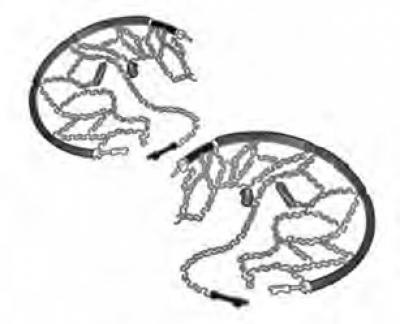
Before attaching snow chains to the tires, remove the wheel covers to prevent scratches.
- Follow the chain manufacturer's instructions.
- Snow chains can only be used on 16" front tires. Do not fit snow chains on tires of a different size.
- Tighten the snow chains after driving approximately 1.0 km.
Attention: The use of snow chains may adversely affect the vehicle's handling.
Do not exceed 50 km/h or the chain manufacturer's recommended speed limit if lower.
Avoid sharp turns, bumps and pits.
Do not brake with locked wheels.
Note: The recommended snow chains for this vehicle are SAE grade, type S.
If the wheels are equipped with snow chains, it is recommended to keep the speed low.
If you hear the sound of the chains making contact with the vehicle body, stop and reattach the snow chains.
If the sound does not stop, slow down until the sound disappears completely.
